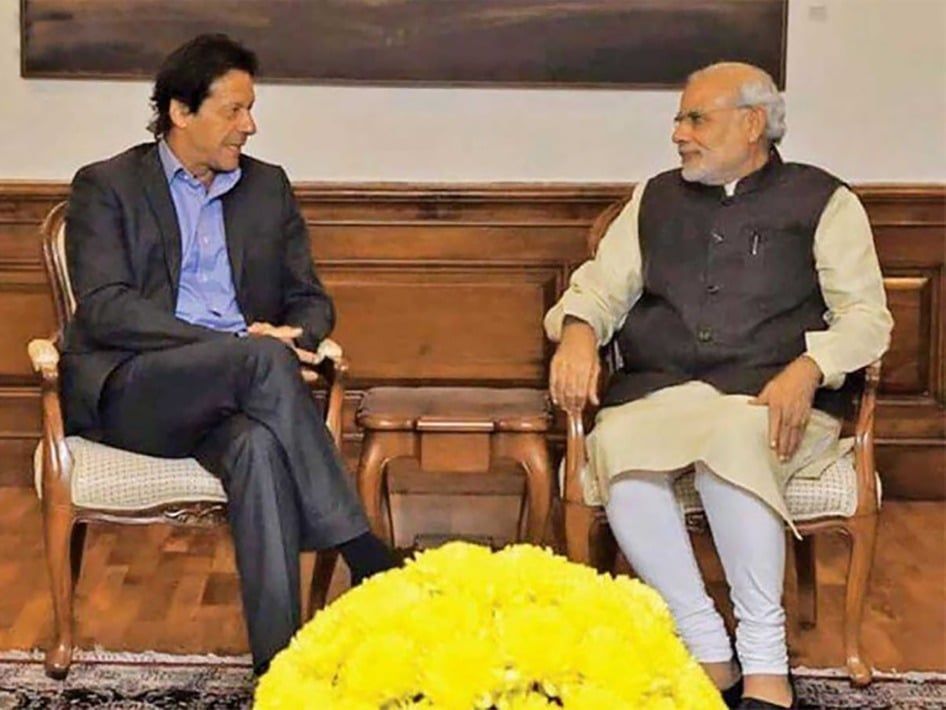India, Pakistan, Kashmir: Taking the war option off the table
By Zia Mian, Abdul H. Nayyar, Sandeep Pandey, M.V. Ramana | September 23, 2019
 Imran Khan of Pakistan (left) and Narenda Modi of India
Imran Khan of Pakistan (left) and Narenda Modi of India
On September 27, Prime Minister Narendra Modi of India and Prime Minister Imran Khan of Pakistan will address the United Nations General Assembly in New York. This appearance will come at a time of great concern about the increasingly hostile relationship between their two countries. At the heart of the matter is the more than 70-year-old dispute that has led the two countries, born out of the partition of British India in 1947, to lay claim to and eventually divide, occupy, and dominate the people and land of Kashmir. The feud over Kashmir led them to war in 1947, 1965, and 1999, and war has been in the air again this year.
The situation in India, Kashmir, and Pakistan seems primed for a hostile action and reaction cycle, resulting in escalating confrontation driven by contested nationalisms, bitter shared histories, and exclusive visions of the future. Indian repression drives Kashmiri resistance fueled by a long-standing demand for freedom that has given rise to both peaceful protests and armed militant factions. Pakistan claims Kashmir and Kashmiris for itself, while restricting the liberties and rights of the Kashmiris it rules, and seeks to punish India for past sins. It now faces unrest from a nascent “growing independence movement” in Pakistan-administered Kashmir. As South Asian scholar and activist Eqbal Ahmad observed grimly, “New Delhi’s moral isolation from the Kashmiri people is total and irreversible…. [while] Pakistan’s governments and politicians have pursued policies which have all but disregarded the history, culture, and aspirations of Kashmir’s people.”
There is an urgent need for ways to prevent any eruption of armed conflict. One option is to resurrect an old idea proposed at various times by both India and Pakistan but never fully agreed: a binding commitment never to resort to war to settle their disputes.
Drifting to war. The immediate path to the present crisis can be traced to a fraught 14-day period earlier this year. As part of a renewed and increasingly home-grown Kashmiri insurgency, a suicide attack in late February by a young Kashmiri militant killed over 40 Indian paramilitary personnel in the town of Pulwama in India-administered Kashmir. India, then preparing for a general election, responded with an airstrike across the border in Pakistan. The target in the town of Balakot was said to be a training camp for the militant group that claimed responsibility for the Pulwama attack.
In retaliation, the Pakistan Air Force targeted an Indian site across the Line of Control that has divided Kashmir since 1948, shooting down an Indian fighter plane in the resulting dogfight and capturing its pilot inside Pakistani territory. The Indian pilot was soon released, and a further escalation was averted.
Using its forcefulness in this crisis as a campaign issue, in May, Narendra Modi’s Hindu nationalist Bharatiya Janata Party (BJP) won a decisive victory in the general election on a hard-line platform, returning to power with a larger majority in parliament. In August, in a surprise move, under the pretext of protecting Hindu devotees on a pilgrimage, the new government moved an additional 38,000 troops into Kashmir and asked the pilgrims to leave. Parliament, acting on a BJP campaign promise, then abrogated Articles 370 and 35A of the Indian Constitution. These articles, largely overridden in practice, had been intended to confer special autonomous status to Kashmir as part of an agreement in 1949.
The new measure by the Modi government divided the state into two units and put them under direct control of the national government. To forestall protest, the Indian government took the extraordinary step of cutting off all communication links within Kashmir and imposing a blanket curfew that left Kashmiris “besieged, confused, frightened and furious”; the curfew has not yet been fully lifted, even a month later. This step has harshly reinforced an earlier image of Kashmir as “the country without a post office” offered by the late Kashmiri poet Agha Shahid Ali from a time when repression and violence led to all the post offices there being closed for seven months.
It was in this heated environment that on August 16, Indian defense minister Rajnath Singh indicated that India may review its long-standing pledge not to be the first to use nuclear weapons in any confrontation, declaring that “India has strictly adhered to this [no-first-use] doctrine. What happens in future depends on the circumstances.” Many in Pakistan took this statement to be a clear sign of what the Pakistani foreign minister called “India’s irresponsible and belligerent behaviour.”
Some Kashmiri militant groups, which have long found in Pakistan a diplomatic champion for their cause and a source of covert military support, now see an opportunity for a war that will finally put matters to rest. Syed Salahuddin, a militant leader who heads an alliance of over a dozen groups fighting Indian rule in Kashmir, said in early September, “It’s binding upon the armed forces of Pakistan, the first Islamic nuclear power, to enter India-occupied Kashmir to militarily help the people of the territory.”
Imran Khan offered one measure of the current peril in a recent New York Times op-ed, where he threatened, “If the world does nothing to stop the Indian assault on Kashmir and its people, there will be consequences for the whole world as two nuclear-armed states get ever closer to a direct military confrontation.”
In a subsequent interview Khan raised the spectre of a fifth and perhaps final war with India, declaring, “If say Pakistan, God forbid, we are fighting a conventional war, we are losing, and if a country is stuck between the choice: either you surrender or you fight ‘til death for your freedom, I know Pakistanis will fight to death for their freedom. So when a nuclear-armed country fights to the end, to the death, it has consequences.” These consequences, left unspoken, would be catastrophic not only for the people of India, Pakistan, and Kashmir, but for the entire world because of the long-range, long-term environmental consequences of the smoke from South Asian cities set ablaze by nuclear attacks.
A no-war pact. The possibility of a treaty rejecting war as an option between India and Pakistan has a long and surprising history, one full of missed opportunities. The notion is in fact almost as old as the two countries themselves.
After Pakistan’s first attempt to seize Kashmir by force in 1947 failed, ending in a cease-fire, a forced division of Kashmir, and a search for some kind of negotiated settlement, Indian Prime Minister Jawaharlal Nehru, in 1949, offered Pakistan a no-war declaration. Pakistan’s Prime Minister Liaquat Ali Khan accepted, provided there was a timetable for settling all outstanding disputes through negotiation and arbitration. No timetable was forthcoming, and no arbitration was agreeable to India.
The two subsequent wars between India and Pakistan also resulted in promises that are in line with the ideas that might underlie a No War agreement. The first of these wars took place in 1965, when beefed up by US military aid and weapons and training, and feeling secure in its patron, Pakistan was ready to try again to force a resolution of the Kashmir issue. It sent in soldiers under cover as insurgents to try to instigate an uprising among Kashmiris against Indian rule. The plan failed and Indian troops invaded Pakistan in reprisal.
The war lasted only 17 days, and both countries looked for arbitration which was provided by the Soviet Union, and led in January 1966 to India and Pakistan signing the Tashkent Declaration, declaring that they would “settle their disputes through peaceful means,” commit to “the principle of non-interference in the internal affairs of each other,” and “discourage any propaganda directed against the other country.” It was all for naught.
A few years later, in 1971, there was the third India-Pakistan war, the only one that has not been about Kashmir. This war resulted in a humiliating defeat for Pakistan and the independence of the former East Pakistan as the new state of Bangladesh. In the Simla Agreement ending that conflict, India and Pakistan again agreed to settle differences peacefully through bilateral talks or any other mutually agreed-upon means. With India feeling victorious and dominant, there were no talks, and they could not agree on other means.
Having failed in war and with no prospect of negotiations on Kashmir, Pakistan resorted to supporting militant movements both in Kashmir and elsewhere in India. This option came into its own in the late-1980s after the Indian government rigged the state-level elections in Kashmir in favor of its allies. As frustrated Kashmiris protested and were terrorized by Indian forces, some became more militant and turned to armed struggle, creating an insurgency. Pakistan saw an opportunity.
Pakistan’s weapon of choice was to redeploy the Islamist militants who, with active US support, had fought in Afghanistan against the Soviet Union. Once unleashed on Kashmir, the Islamists changed the nature of the struggle there, making it increasingly violent and brutal. Since then India has suffered attacks on numerous civilian targets, including the hijacking of a commercial airliner, an attack on its parliament, carnage in Mumbai, and deadly attacks on military camps and civilians. India started to pay back in the same coin by supporting militant movements in Pakistan, especially in Balochistan and in the Pakhtun tribal region adjacent to Afghanistan.
Amidst all this, the no-war pact surfaced again in 1981. Pakistan’s ruler General Zia-ul Haq, who had taken power in a coup in 1977, made the offer “to enter into immediate consultations with India for the purpose of exchanging mutual guarantees of nonaggression and non-use of force.” The two sides exchanged detailed position papers but the process soon stalled over Kashmir. Still, India’s prime minister, Indira Gandhi, declared that even without a no-war pact, India would not attack Pakistan first. In 1984, the two countries tried again to explore this option, but no agreement could be reached.
In the aftermath of the nuclear tests in 1998, to show that they were capable of acting responsibly, the leaders of India and Pakistan agreed as part of the Lahore Declaration
of February 1999 to intensify their efforts to resolve all issues. This was to include settling the issue of Kashmir, refraining from intervention and interference in each other’s internal affairs, and combating the menace of terrorism in all its manifestations. These intentions were to prove short lived as the two countries went to war in mid-1999 in the Kargil area of Indian-administered Kashmir.
The no-war pact proposal was put back on the table by Pakistan’s General Pervez Musharraf at the United Nations Millennium Summit in September 2000. Once again, India declined. Coming so soon after the Kargil war, India’s reluctance was to be expected; Indians thought that such an agreement would provide Pakistan a shield behind which to run its proxy wars in Kashmir without fear of large-scale reprisal. Musharraf, after all, was the architect of the Kargil war.
Things have changed radically since then, however. Pakistan has recognized that in a nuclear-armed subcontinent, Kashmir cannot be wrested from India by force. In addition to having suffered blowback from promoting Islamist militants as proxies, it also understands that no state can now be seen to support Islamist guerrillas without eliciting international censure. In fact, Pakistan is currently under scrutiny by the international Financial Action Task Force, which was formed to fight terrorist financing and money laundering. Such scrutiny puts Pakistan at risk of sanctions, which it can ill afford given its severe economic crisis.
India’s leaders seek desperately to focus on economic growth to give substance to their ambitions of being an emerging great power on a par with China and as a path to gaining public support to consolidate their hold on power. This was a key issue in helping bring Narendra Modi to power in 2014 and in his re-election in 2019. This effort has faltered as India suffers the worst rate of unemployment in 45 years and a slide in its economic growth rate to a six year low. Such nationalist and economic dreams are bound to stumble on the realities of an alienated population in Kashmir (and elsewhere in India), periodic bouts of civil unrest and insurgency, and proxy wars from across the border. This is no path to a robust social peace.
Time to try again. As they prepare to speak at the United Nations, Narendra Modi of India and Imran Khan of Pakistan should take a careful look at the idea of a no-war agreement to calm India-Pakistan relations for the long term. Both leaders could reiterate and take seriously the commitments that their countries have already made to recognize each other’s security concerns and agree to take war off the table. Their people at home and the world leaders gathered in New York should press them on this issue.
The key to a viable no-war pact will be agreement on the definition of what would constitute an act of war. Making public the full record of earlier India-Pakistan discussions on a war pact would help set the table for trying again. Past experience and current conditions suggest an initial list of prohibited acts under such an agreement might include:
- using or threatening the use of armed forces and weapons of war against the other country,
- invading the territory of the other country,
- supporting armed insurrectionary groups in the other country,
- committing or helping to commit acts of sabotage and disruption of civil life in the territory of the other country,
- blockading or obstructing in any way land, sea, or air access routes of the other country to the outside world,
- disrupting the flow of river water to the other country,
- disseminating or helping to disseminate hostile propaganda against the other country,
- joining trade wars waged by a third party against the other country,
- meddling in or exacerbating any internal dispute in the other country,
- entering into strategic alliance with any world power against the other party,
- any other action mutually agreed as constituting an act of war.
Since some of these are general categories and may be open to interpretation, so a no-war pact may need to include an adjudication commission for settling disputes over possible violations. Its rulings would have to be binding. The commission might include Indian and Pakistani officials, prominent members of civil society, and representatives from regional and international organizations. The two countries could also agree to accept the International Court of Justice as the arbitrator.
After the pact has been negotiated and entered into force, governments in India or Pakistan may find themselves still facing political strife, protest, militancy and insurgency. It will be for the Adjudication Commission to conclude whether or not these movements are inspired from across the border or reflect a home-grown failure of governance. No longer credibly able to blame resistance to their injustices on a foreign hand, leaders in India and Pakistan will need to find a way to deal with domestic unrest through democracy and politics.
A no-war pact as outlined here is not meant as a panacea. Rather, it offers a stable and secure security framework that can enable India and Pakistan to develop more peaceful and constructive relations with confidence.
It is possible that, with war taken off the table, the fears and misgivings India and Pakistan have nurtured for decades would begin to diminish. This would allow their arms race to subside. Economy, politics, and culture could begin to move away from a focus on mutual hostility and confrontation to accommodation and cooperation. The poor in both countries could hope to benefit from the peace dividend.
Together, we make the world safer.
The Bulletin elevates expert voices above the noise. But as an independent nonprofit organization, our operations depend on the support of readers like you. Help us continue to deliver quality journalism that holds leaders accountable. Your support of our work at any level is important. In return, we promise our coverage will be understandable, influential, vigilant, solution-oriented, and fair-minded. Together we can make a difference.
Keywords: Imran Khan, Narendra Modi
Topics: Analysis, Nuclear Weapons
















